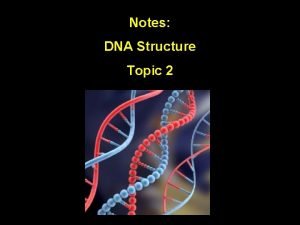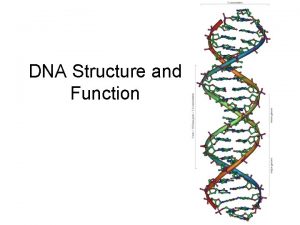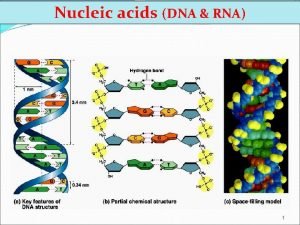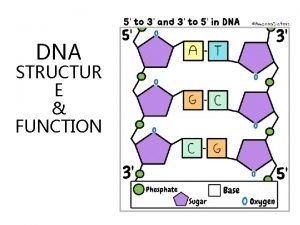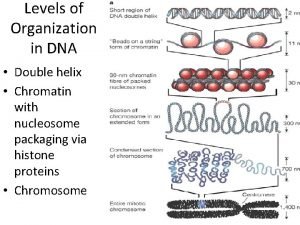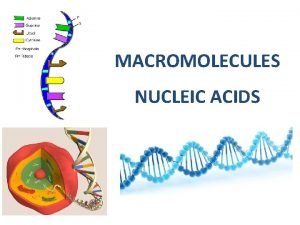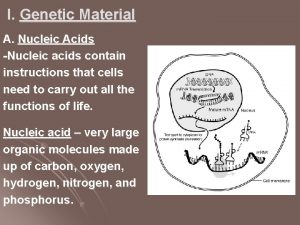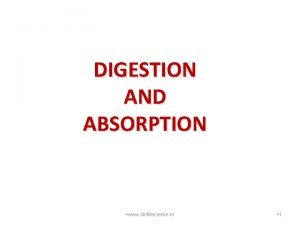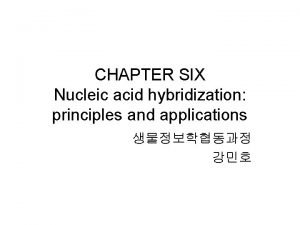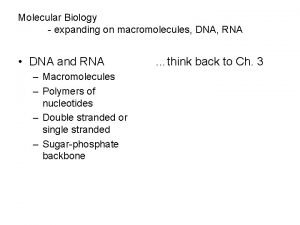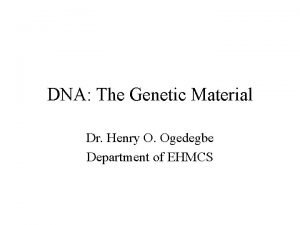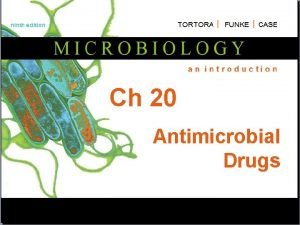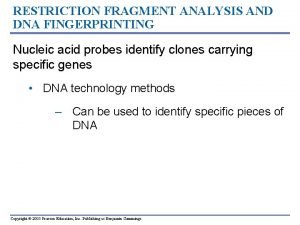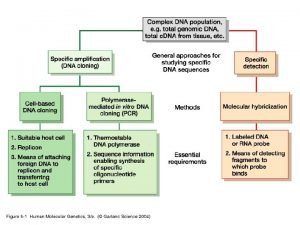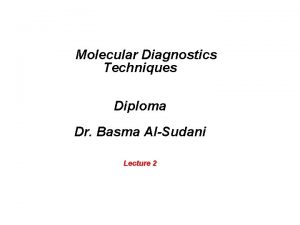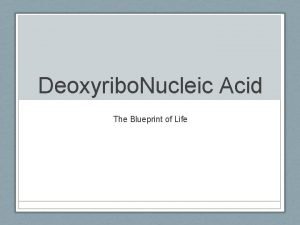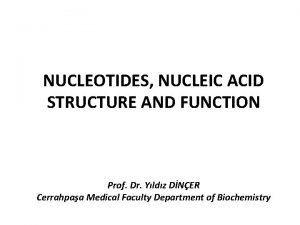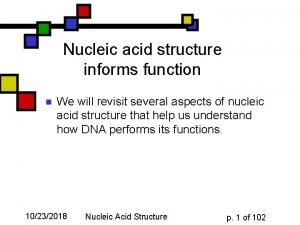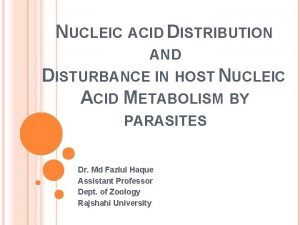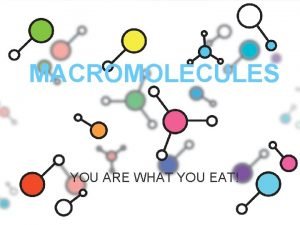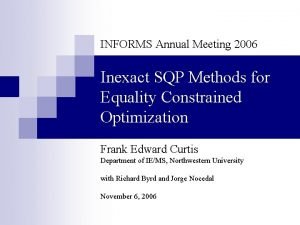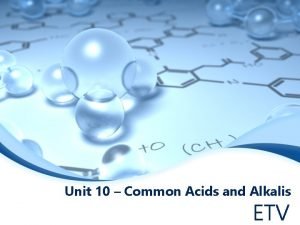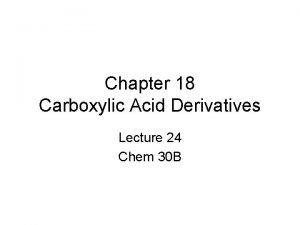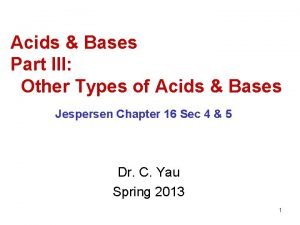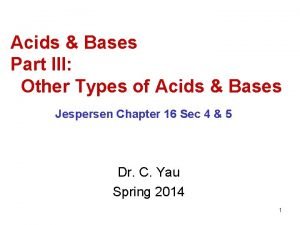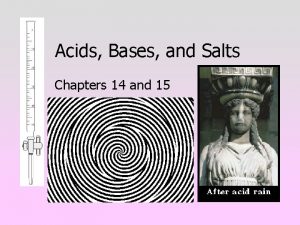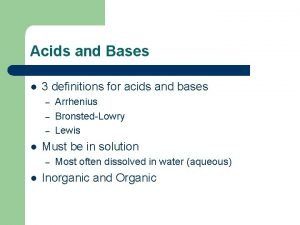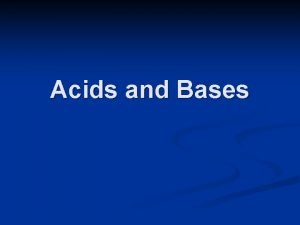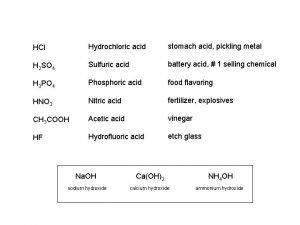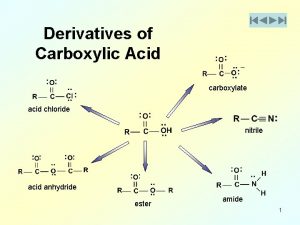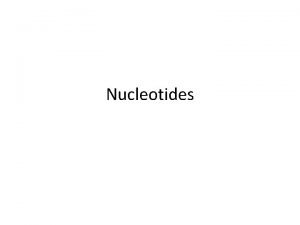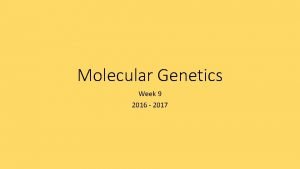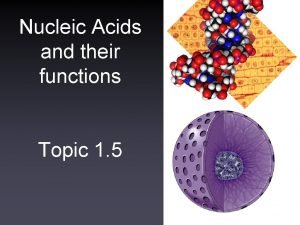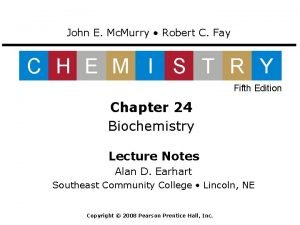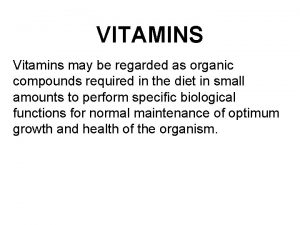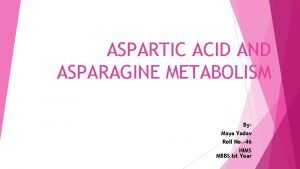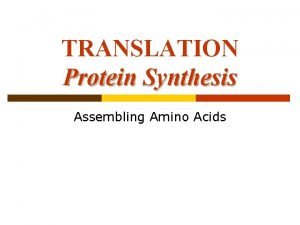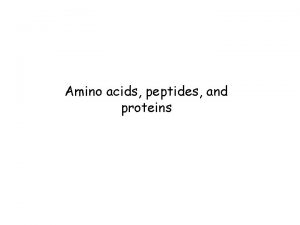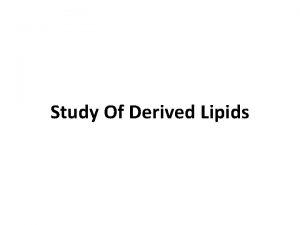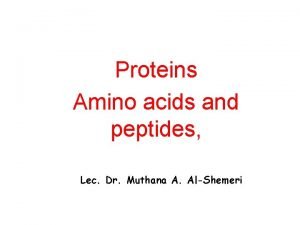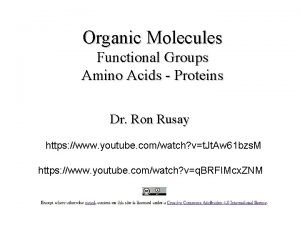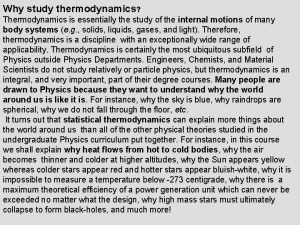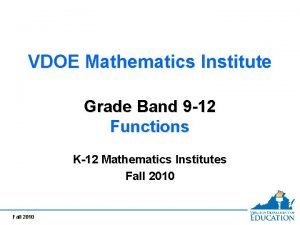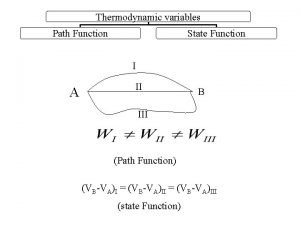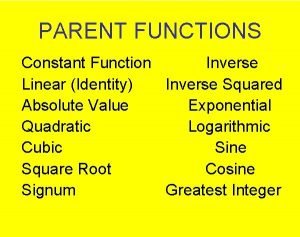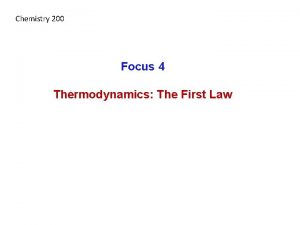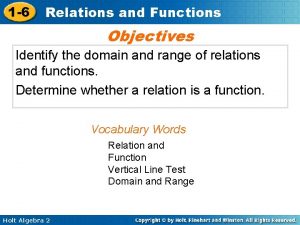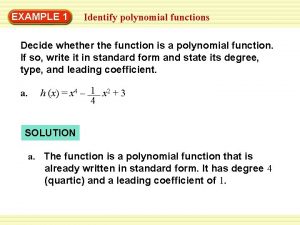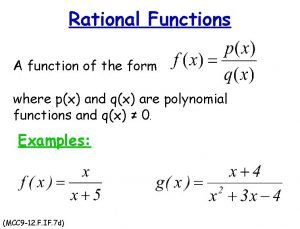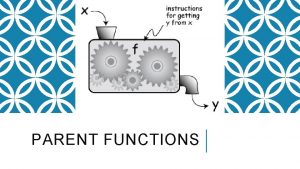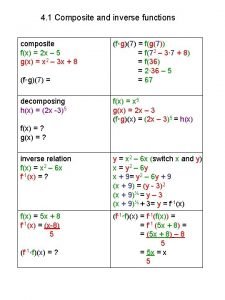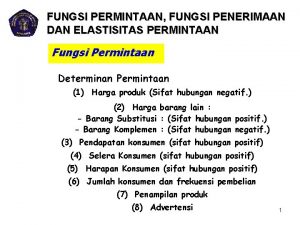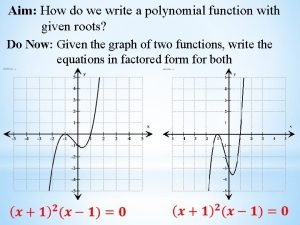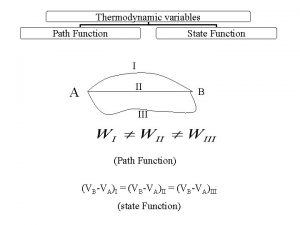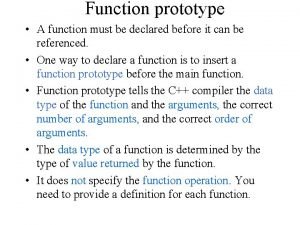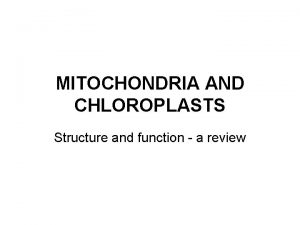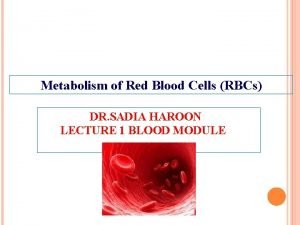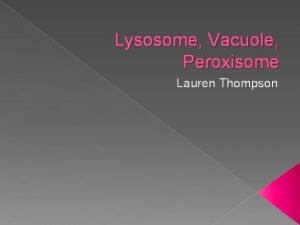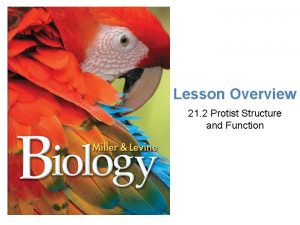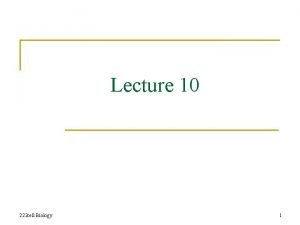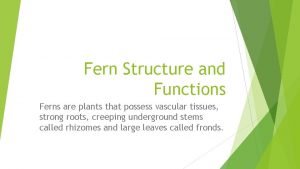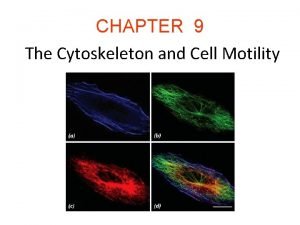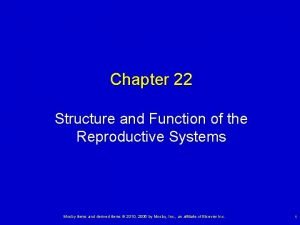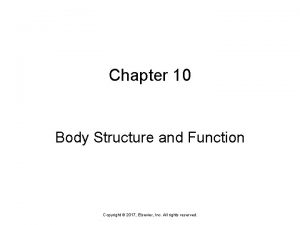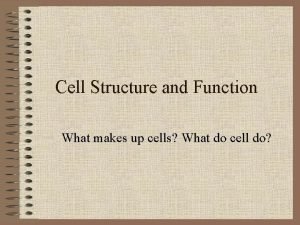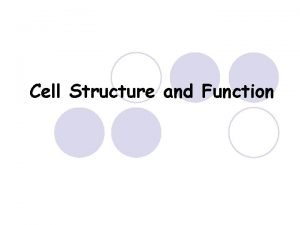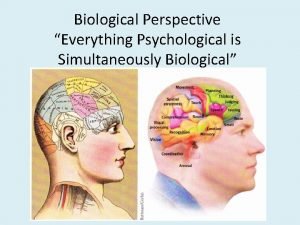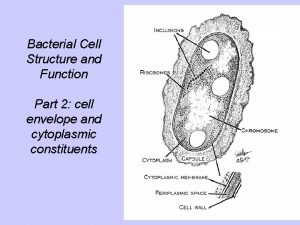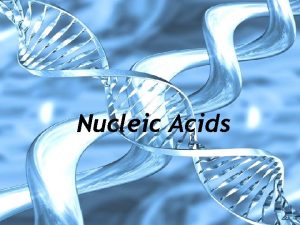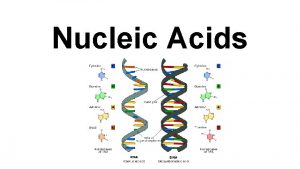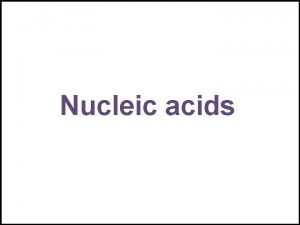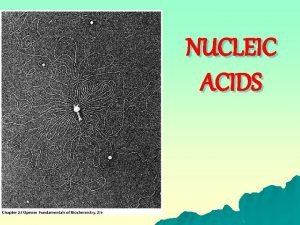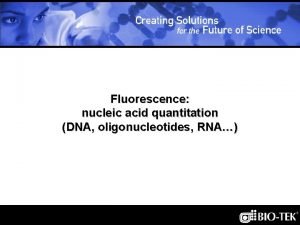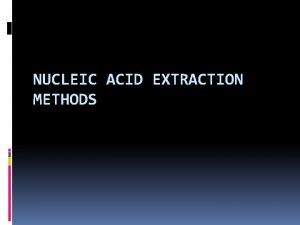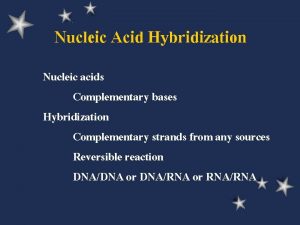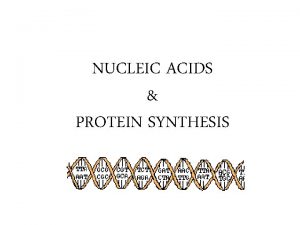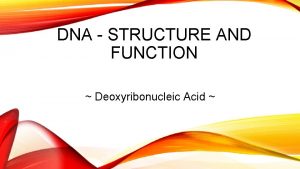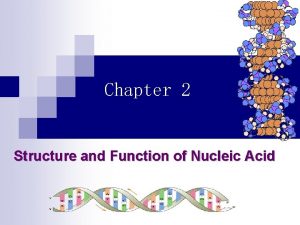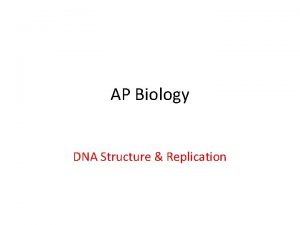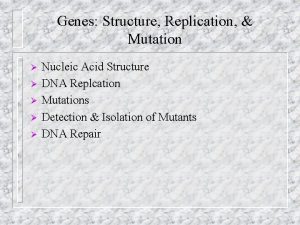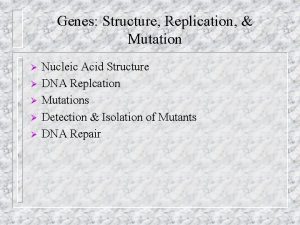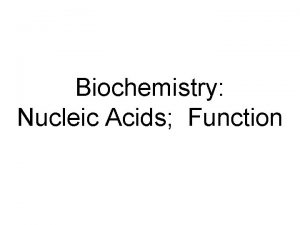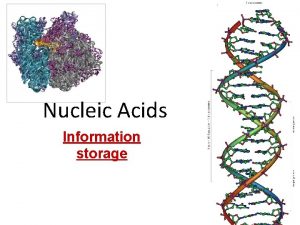Nucleic acid structure informs function n We will





































![Base composition for DNA n n As noted, [A]=[T], [C]=[G] because of base pairing Base composition for DNA n n As noted, [A]=[T], [C]=[G] because of base pairing](https://slidetodoc.com/presentation_image/502d41d52582cd4c4117a70ed86639be/image-38.jpg)


































































- Slides: 104

Nucleic acid structure informs function n We will revisit several aspects of nucleic acid structure that help us understand how DNA performs its functions. 10/23/2018 Nucleic Acid Structure p. 1 of 102

Nucleic Acid Structure Andy Howard Macromolecular Structure 23 October 2018

What we’ll discuss n n n n Bases Nucleotides Polynucleotides Density Stability Denaturation and renaturation A, B, Z DNA 10/23/2018 Nucleic Acid Structure n Tertiary structure Supercoiling n Gyrases n Nucleosomes n Higher levels n n RNA Types & functions n Bases & structures n p. 3 of 102

10/23/2018 Nucleic Acid Structure p. 4 of 102

10/23/2018 Nucleic Acid Structure p. 5 of 102

Pyrimidines n n n Single-ring nucleic acid bases 6 -atom ring; always two nitrogens in the ring, meta to one another Based on pyrimidine, although pyrimidine itself is not a biologically important molecule Variations depend on oxygens and nitrogens attached to ring carbons Tautomerization possible Note line of symmetry in pyrimidine structure 10/23/2018 Nucleic Acid Structure 5 6 4 1 2 3 p. 6 of 102

Uracil and thymine n n Uracil is a simple dioxo derivative of pyrimidine: 2, 4 -dioxopyrimidine Thymine is 5 -methyluracil Uracil is found in RNA; Thymine is found in DNA We can draw other tautomers where we move the protons to the oxygens 10/23/2018 Nucleic Acid Structure p. 7 of 102

Tautomers n n Lactam and lactim forms Getting these right was essential to Watson & Crick’s development of the DNA double helical model 10/23/2018 Nucleic Acid Structure p. 8 of 102

Cytosine n n This is 2 -oxo, 4 -aminopyrimidine It’s the other pyrimidine base found in DNA & RNA Can undergo spontaneous deamination (C U) Again, other tautomers can be drawn 10/23/2018 Nucleic Acid Structure p. 9 of 102

Cytosine: amino and imino forms n Again, this tautomerization needs to be kept in mind 10/23/2018 Nucleic Acid Structure p. 10 of 102

Purines n n 5 1 8 4 2 n 7 6 3 9 Derivatives of purine; again, the root molecule isn’t biologically important Six-membered ring looks a lot like pyrimidine Numbering works somewhat differently: note that the glycosidic bonds will be to N 9, whereas it’s to N 1 in pyrimidines 10/23/2018 Nucleic Acid Structure p. 11 of 102

Adenine n n This is 6 -aminopurine Found in RNA and DNA We’ve seen how important adenosine and its derivatives are in metabolism Tautomerization happens here too 10/23/2018 Nucleic Acid Structure p. 12 of 102

Guanine n n n This is 2 -amino-6 -oxopurine Found in RNA, DNA Lactam, lactim forms 10/23/2018 Nucleic Acid Structure p. 13 of 102

Other natural purines n n Hypoxanthine and xanthine are biosynthetic precursors of A & G Urate is important in nitrogen excretion pathways 10/23/2018 Nucleic Acid Structure p. 14 of 102

Tautomerization and H-bonds n n n Lactam forms predominate at neutral p. H This influences which bases are H-bond donors or acceptors Amino groups in C, A, G make H-bonds So do ring nitrogens at 3 in pyrimidines and 1 in purines … and oxygens at 4 in U, T, 2 in C, 6 in G 10/23/2018 Nucleic Acid Structure p. 15 of 102

Nucleosides n n n These are glycosides (covalent adducts containing sugar) of the nucleic acid bases Sugar is always ribose or deoxyribose, in their furanose (5 -membered ring) form Connected nitrogen is: n n N 1 for pyrimidines (on 6 -membered ring) N 9 for purines (on 5 -membered ring) 10/23/2018 Nucleic Acid Structure p. 16 of 102

Pyrimidine nucleosides n Drawn here in amino and lactam forms uridine 10/23/2018 Nucleic Acid Structure cytidine p. 17 of 102

Pyrimidine deoxynucleosides deoxyuridine 10/23/2018 deoxythymidine Nucleic Acid Structure deoxycytidine p. 18 of 102

A tricky nomenclature issue n n Remember that thymidine and its phosphorylated derivatives ordinarily occur associated with deoxyribose, not ribose Therefore many people leave off the deoxyprefix in names of thymidine and its derivatives: it’s usually assumed. 10/23/2018 Nucleic Acid Structure p. 19 of 102

Purine nucleosides n Drawn in amino and lactam forms adenosine 10/23/2018 Nucleic Acid Structure guanosine p. 20 of 102

Purine deoxynucleosides deoxyadenosine deoxyguanosine 10/23/2018 Nucleic Acid Structure p. 21 of 102

Monophosphorylated nucleosides n n We have specialized names for the 5’-phospho derivatives of the nucleosides, i. e. the nucleoside monophosphates: They are nucleotides, including Adenosine 5’monophosphate = AMP = adenylate 10/23/2018 Nucleic Acid Structure adenylate p. 22 of 102

Three other nucleotides cytidylate = CMP guanylate = GMP uridylate = UMP 10/23/2018 Nucleic Acid Structure p. 23 of 102

Deoxynucleotides n Similar nomenclature n n n d. UMP = deoxyuridylate d. AMP = deoxyadenylate d. GMP = deoxyguanylate d. CMP = deoxycytidylate d. TMP (= TMP) = deoxythymidylate = thymidylate 10/23/2018 Nucleic Acid Structure Deoxyuridylate = d. UMP p. 24 of 102

Di- and triphosphates n Phosphoanhydride bonds link second and perhaps third phosphates to the 5’-OH on the ribose moiety 10/23/2018 GDP Nucleic Acid Structure CTP p. 25 of 102

Cyclic phosphodiesters n n 3’ and 5’ hydroxyls are both involved in -O-P-O bonds c. AMP and c. GMP are the important ones 10/23/2018 Nucleic Acid Structure Cyclic AMP p. 26 of 102

Glycosidic bonds n This illustrates the roughly perpendicular positionings of the base and sugar rings 10/23/2018 Nucleic Acid Structure p. 27 of 102

Conformations around the glycosidic bond n n Rotation of the base around the glycosidic bond is sterically hindered In the syn conformation there would be some interference between the sugar ring and the 2 -position of the base 10/23/2018 Nucleic Acid Structure p. 28 of 102

How this really plays out n n Therefore pyrimidines are always anti, and purines are usually anti Furanose and base rings are roughly perpendicular 10/23/2018 Nucleic Acid Structure p. 29 of 102

Nucleotide Oligomers and Polymers n n n Monomers are nucleotides or deoxynucleotides Linkages are phosphodiester linkages between 3’ of one ribose and 5’ of the next ribose It’s logical to start from the 5’ end for synthetic reasons 10/23/2018 Nucleic Acid Structure p. 30 of 102

Typical DNA dinucleotide n n Various notations: this is pd. Apd. Cp Leave out the p’s if there’s a lot of them! 10/23/2018 Nucleic Acid Structure p. 31 of 102

DNA structure n n Many years of careful experimental work enabled fabrication of double-helical model of double-stranded DNA Explained [A]=[T], [C]=[G] 10/23/2018 Nucleic Acid Structure p. 32 of 102

Stability of the double helix n n Specific H-bonds stabilize double-helical structure These H-bonds aren’t responsible for all of the stability of the double helix! 10/23/2018 Nucleic Acid Structure p. 33 of 102

What does double-stranded DNA really look like? n n Picture on earlier slide emphasizes only the Hbond interactions; it ignores the orientation of the sugars, which are actually tilted relative to the helix axis Planes of the bases are almost perpendicular to the helical axes on both sides of the double helix 10/23/2018 Nucleic Acid Structure p. 34 of 102

Sizes n n Diameter of the double helix: 2. 37 nm Length along one full turn: 10. 4 base pairs = pitch = 3. 40 nm Distance between stacked base pairs = rise = 0. 33 nm Major groove is wider and shallower; minor groove is narrower and deeper 10/23/2018 Nucleic Acid Structure p. 35 of 102

GC-rich DNA is denser n n DNA is denser than RNA or protein, period, because it can coil up so compactly Therefore density-gradient centrifugation separates DNA from other cellular macromolecules GC-rich DNA is 3% denser than AT-rich Can be used as a quick measure of GC content 10/23/2018 Nucleic Acid Structure p. 36 of 102

Density as function of GC content 10/23/2018 Nucleic Acid Structure p. 37 of 102
![Base composition for DNA n n As noted AT CG because of base pairing Base composition for DNA n n As noted, [A]=[T], [C]=[G] because of base pairing](https://slidetodoc.com/presentation_image/502d41d52582cd4c4117a70ed86639be/image-38.jpg)
Base composition for DNA n n As noted, [A]=[T], [C]=[G] because of base pairing [A]/[C] etc. not governed by base pairing n n Can vary considerably E. coli : [A], [C] about equal Mycobacterium tuberculosis: [C] > 2*[A] Mammals: [C] < 0. 74*[A] 10/23/2018 Nucleic Acid Structure p. 38 of 102

What stabilizes DNA? n Variety of stabilizing interactions n n Stacking of base pairs Hydrogen bonding between base pairs Hydrophobic effects (burying bases, which are less polar) Courtesy Charge-charge interactions: phosphates with Mg 2+ & cationic dnareplication. info proteins 10/23/2018 Nucleic Acid Structure p. 39 of 102

How close to instability is it? n n Pretty close. Heating DNA makes it melt p. H > 10 separates strands too The more GC pairs, the harder it is to melt DNA thermally n n 10/23/2018 Weaker stacking interactions in A-T One more H-bond per GC than per AT Nucleic Acid Structure p. 40 of 102

Denaturing and Renaturing DNA n n When DNA is heated to > 80ºC, its UV absorbance increases by 30 -40% This hyperchromic shift reflects the unwinding of the DNA double helix Stacked base pairs in native DNA absorb less light When T is lowered, the absorbance drops, reflecting the re-establishment of stacking 10/23/2018 Nucleic Acid Structure p. 41 of 102

Heat denaturation n Figure 11. 14 Heat denaturation of DNA from various sources, so-called melting curves. The midpoint of the melting curve is defined as the melting temperature, Tm. (From Marmur, J. , 1959. Nature 183: 1427– 1429. ) 10/23/2018 Nucleic Acid Structure p. 42 of 102

GC content vs. melting temp n High salt and no chelators raises the melting temperature 10/23/2018 Nucleic Acid Structure p. 43 of 102

How else can we melt DNA? n n High p. H deprotonates the bases so the Hbonds disappear Low p. H hyper-protonates the bases so the H-bonds disappear Alkalai is better: it doesn’t break the glycosidic linkages Urea, formamide make better H-bonds than the DNA itself so they denature DNA 10/23/2018 Nucleic Acid Structure p. 44 of 102

What happens if we separate the strands? n n We can renature the DNA into a double helix Requires re-association of 2 strands: reannealing The realignment can go wrong Association is 2 nd-order, zippering is first order and therefore faster 10/23/2018 Nucleic Acid Structure p. 45 of 102

Steps in denaturation and renaturation 10/23/2018 Nucleic Acid Structure p. 46 of 102

Rate depends on complexity n n The more complex DNA is, the longer it takes for nucleation of renaturation to occur “Complex” can mean “large”, but complexity is influenced by sequence randomness: poly(AT) is faster than a random sequence 10/23/2018 Nucleic Acid Structure p. 47 of 102

Second-order kinetics n n n Rate of association: -dc/dt = k 2 c 2 Boundary condition is fully denatured concentration c 0 at time t=0: c / c 0 = (1+k 2 c 0 t)-1 Half time is t 1/2 = (k 2 c 0)-1 Routine depiction: plot c 0 t vs. fraction reassociated (c /c 0) and find the halfway point. 10/23/2018 Nucleic Acid Structure p. 48 of 102

Typical c 0 t curves 10/23/2018 Nucleic Acid Structure p. 49 of 102

Helical twist n n Rotation about the backbone axis Successive basepairs rotated with respect to each other by ~ 32º 10/23/2018 Nucleic Acid Structure p. 50 of 102

Propeller twist n Improves overlap of hydrophobic surfaces 10/23/2018 Nucleic Acid Structure p. 51 of 102

What propeller twist accomplishes n Makes it harder for water to contact the less hydrophilic parts of the molecule 10/23/2018 Nucleic Acid Structure p. 52 of 102

DNA secondary structures n If double-stranded DNA were simply a straight -legged ladder: n n Base pairs would be 0. 6 nm apart Watson-Crick base-pairs have very uniform dimensions because the H-bonds are fixed lengths But water could get to the apolar bases So, in fact, the ladder gets twisted into a helix. 10/23/2018 Nucleic Acid Structure p. 53 of 102

B-DNA: introduction n n The most common helix is B-DNA, but there are others. B-DNA’s properties include: n n 10/23/2018 Sugar-sugar distance is still 0. 6 nm Helix repeats itself every 3. 4 nm, i. e. 10 bp Nucleic Acid Structure p. 54 of 102

Properties of B-DNA n n n Spacing between base-pairs along helix axis = 0. 33 nm 10 base-pairs per full turn So: 3. 4 nm per full turn is pitch length Major and minor grooves, as discussed earlier Base-pair plane is almost perpendicular to helix axis 10/23/2018 Nucleic Acid Structure From Molecular Biology web-book p. 55 of 102

Major groove in B-DNA n n n H-bond between adenine NH 2 and thymine ring C=O H-bond between cytosine amine and guanine ring C=O Wide, not very deep 10/23/2018 Nucleic Acid Structure Image courtesy UCLA Chemistry p. 56 of 102

Minor groove in B-DNA n n n H-bond between adenine ring N and thymine ring NH H-bond between guanine amine and cytosine ring C=O Narrow but deep 10/23/2018 Nucleic Acid Structure From Berg et al. , Biochemistry p. 57 of 102

Cartoon of AT pair in B-DNA 10/23/2018 Nucleic Acid Structure p. 58 of 102

Cartoon of CG pair in B-DNA 10/23/2018 Nucleic Acid Structure p. 59 of 102

What holds duplex B-DNA together? n n n H-bonds (but just barely) Electrostatics: Mg 2+ –HPO 4 van der Waals interaction: - interactions in bases n n Solvent exclusion Recognize role of grooves in defining DNA-protein interactions 10/23/2018 Nucleic Acid Structure p. 60 of 102

A-DNA n n In low humidity this forms naturally Not likely in cellular duplex DNA, but it does form in duplex RNA & DNA-RNA hybrids because the 2’-OH gets in the way of BRNA 10/23/2018 Nucleic Acid Structure p. 61 of 102

Structural properties of A-DNA and Duplex A-RNA n Broader than B-DNA n n n 2. 46 nm per full turn 11 bp to complete a turn Base-pairs are not perpendicular to helix axis: tilted 19º from perpendicular 10/23/2018 Nucleic Acid Structure p. 62 of 102

Z-DNA n Forms in alternating Py-Pu sequences and occasionally in Py. Pu, especially if C’s are methylated 10/23/2018 Nucleic Acid Structure p. 63 of 102

Structural properties of Z-DNA n n Left-handed helix rather than right Bases zigzag across the groove 10/23/2018 Nucleic Acid Structure p. 64 of 102

Getting from B to Z n n Can be accomplished without breaking bonds … even though the ZDNA purines have their glycosidic bonds flipped (anti syn) and the pyrimidines are flipped altogether! 10/23/2018 Nucleic Acid Structure p. 65 of 102

Summaries of A, B, Z DNA 10/23/2018 Nucleic Acid Structure p. 66 of 102

Tertiary Structure of DNA n n n In duplex DNA, ten bp per turn of helix Circular DNA sometimes has more or less than 10 bp per turn - a supercoiled state Enzymes called topoisomerases or gyrases can introduce or remove supercoils Cruciforms occur in palindromic regions of DNA Negative supercoiling may promote cruciforms 10/23/2018 Nucleic Acid Structure p. 67 of 102

DNA isn’t always flat n n It’s underwound or overwound if the ends are broken, twisted, and rejoined. Supercoils restore 10. 4 bp/turn relation upon rejoining 10/23/2018 Nucleic Acid Structure p. 68 of 102

Supercoiling and flat DNA Diagram courtesy SIU Carbondale 10/23/2018 Nucleic Acid Structure p. 69 of 102

Supercoiling n n Refers to levels of organization of DNA beyond the immediate double-helix We describe circular DNA as relaxed if the closed double helix could lie flat 10/23/2018 Nucleic Acid Structure p. 70 of 102

DNA is wound n n Standard is one winding per helical turn, i. e. 1 winding per 10 bp Fewer coils or more coils can happen: This introduces stresses that favors unwinding Both underwound and overwound DNA compact the DNA so it sediments faster than relaxed DNA 10/23/2018 Nucleic Acid Structure p. 71 of 102

Linking, twists, and writhe n n n T=Twist=number of helical turns W=Writhe=number of supercoils L=T+W = Linking number is constant unless you break covalent bonds 10/23/2018 Nucleic Acid Structure p. 72 of 102

Examples with a tube 10/23/2018 Nucleic Acid Structure p. 73 of 102

How this works with real DNA 10/23/2018 Nucleic Acid Structure p. 74 of 102

How gyrases work n n n Enzyme cuts the DNA and lets the DNA pass through itself Then the enzyme religates the DNA Can introduce new supercoils or take away old ones 10/23/2018 Nucleic Acid Structure p. 75 of 102

Typical gyrase action n n Takes W=0 circular DNA and supercoils it to W=-4 This then relaxes a little by disrupting some base-pairs to make ss. DNA bubbles 10/23/2018 Nucleic Acid Structure p. 76 of 102

Superhelix density n n Compare L for real DNA to what it would be if it were relaxed (W=0): That’s L = L - L 0 Sometimes we want = superhelix density = specific linking difference = L / L 0 Natural circular DNA always has < 0 10/23/2018 Nucleic Acid Structure p. 77 of 102

< 0 and spools n n The strain in < 0 DNA can be alleviated by wrapping the DNA around protein spool That’s part of what stabilizes nucleosomes 10/23/2018 Nucleic Acid Structure p. 78 of 102

Cruciform DNA n n Cross-shaped structures arise from palindromic structures, including interrupted palindromes like this example These are less stable than regular duplexes but they are common, and they do create recognition sites for DNA-binding proteins, including restriction enzymes 10/23/2018 Nucleic Acid Structure p. 79 of 102

Cruciform DNA example 10/23/2018 Nucleic Acid Structure p. 80 of 102

Eukaryotic chromosome structure n n Human DNA’s total length is ~2 meters! This must be packaged into a nucleus that is about 5 micrometers in diameter This represents a compression of more than 100, 000! It is made possible by wrapping the DNA around protein spools called nucleosomes and then packing these in helical filaments 10/23/2018 Nucleic Acid Structure p. 81 of 102

Chromatin n Discovered long before we understood molecular biology Seen to be banded objects in nuclei of stained eukaryotic cells In resting cell it exists as long slender threads, 30 nm diameter 10/23/2018 Nucleic Acid Structure From answers. com p. 82 of 102

Squishing the DNA n n n If the double helix were fully extended, the largest human chromosome (2. 4*108 bp) would be 2. 4*108 *0. 33 nm ~ 0. 8*108 nm=80 mm; much bigger than the cell! So we have to coil it up a lot to make it fit. Longest chromosome is 10µm long So the packing ratio is 80 mm/10µm = 8000 10/23/2018 Nucleic Acid Structure p. 83 of 102

Chromosome structure: levels n Each of the first 4 levels compacts DNA by a factor of 6 -20; those multiply up to > 104 10/23/2018 Nucleic Acid Structure p. 84 of 102

DNA is dynamic n n n Don’t think of these diagrams as static The H-bonds stretch and the torsions allow some rotations, so the ropes can form roughly spherical shapes when not constrained by histones Shape is sequence-dependent, which influences protein-DNA interactions 10/23/2018 Nucleic Acid Structure p. 85 of 102

Types of RNA found in cells Type % %turn. RNA over m. RNA 3 25 t. RNA 15 21 r. RNA 80 50 s. RNA 10/23/2018 2 4 Size, Partly Role bases DS? 50 -104 no protein template 55 -90 yes aa activation 102 -104 yes transl. catalysis & scaffolding 15 -103 yes various Nucleic Acid Structure p. 86 of 102

Messenger RNA n n m. RNA: transcription vehicle DNA 5’-d. Ad. Cd. Gd. Td. Ad. Td. G-3’ RNA 3’- U G G C A U A C-5’ typical protein is ~500 amino acids; 3 m. RNA bases/aa: 1500 bases (after splicing) Additional noncoding regions (see later) brings it up to ~4000 bases = 4000*300 Da/base=1, 200, 000 Da Only about 3% of cellular RNA but unstable! 10/23/2018 Nucleic Acid Structure p. 87 of 102

Relative quantities n n Note that we said there wasn’t much m. RNA around at any given moment Amount synthesized is much greater because it has a much shorter lifetime than the others Ribonucleases act more avidly on it Need a mechanism for eliminating it: the cell wants to control concentrations of specific proteins 10/23/2018 Nucleic Acid Structure p. 88 of 102

m. RNA processing in Eukaryotes Genomic DNA n n n Unmodified m. RNA produced therefrom # bases (unmodified m. RNA) = # base-pairs of DNA in the gene… because that’s how transcription works BUT # of bases in the unmodified m. RNA > # bases in the final m. RNA that actually codes for a protein SO there needs to be a process for getting rid of the unwanted bases in the m. RNA: that’s what splicing is! 10/23/2018 Nucleic Acid Structure p. 89 of 102

Splicing: quick summary Genomic DNA transcription Unmodified m. RNA produced therefrom exon intron exon splicing exon (Mature transcript) n n intron exon intron translation Initial eukaryotic message = roughly twice as many bases as the final processed message Spliceosome is the nuclear machine (sn. RNAs + protein) in which the introns are removed and the exons are spliced together 10/23/2018 Nucleic Acid Structure p. 90 of 102

Heterogeneity via spliceosomal flexibility n n Specific RNA sequences in the initial m. RNA signal where to start and stop each intron, but with some flexibility That flexibility enables a single gene to code for multiple mature RNAs and therefore multiple proteins 10/23/2018 Nucleic Acid Structure p. 91 of 102

Transfer RNA n n t. RNA: tool for engineering protein synthesis at the ribosome Each type of amino acid has its own t. RNA, responsible for positioning the Yeast Phe t. RNA 76 bases correct aa into the growing protein PDB 1 EVV, 2Å Roughly T-shaped or Y-shaped molecules; generally 55 -90 bases long 15% of cellular RNA 10/23/2018 Nucleic Acid Structure p. 92 of 102

Secondary and Tertiary Structure of t. RNA n n Extensive H-bonding creates four double helical domains, three capped by loops, one by a stem Synthetic asp Few t. RNA structures (alone) are known t. RNA phe t. RNA, asp t. RNA are L-shaped 24 k. Da monomer Many non-canonical bases found in t. RNA PDB 1 VTQ, 3Å 10/23/2018 Nucleic Acid Structure p. 93 of 102

t. RNA structure: overview 10/23/2018 Nucleic Acid Structure p. 94 of 102

Amino acid linkage to acceptor stem Amino acids are linked to the 3'-OH end of t. RNA molecules by an ester bond formed between the carboxyl group of the amino acid and the 3'-OH of the terminal ribose of the t. RNA. 10/23/2018 Nucleic Acid Structure p. 95 of 102

Yeast alat. RNA n Note nonstandard bases and cloverleaf structure 10/23/2018 Nucleic Acid Structure p. 96 of 102

Ribosomal RNA n n r. RNA: catalyic and scaffolding functions within the ribosome Responsible for ligation of new amino acid (carried by t. RNA) onto growing protein chain 10/23/2018 Nucleic Acid Structure Haloarcula marismortui 23 S r. RNA PDB 1 FFZ 602 bases p. 97 of 102

Ribosomal RNA, continued n n n Can be large: mostly 500 -3000 bases a few are smaller (150 bases) Very abundant: 80% of cellular RNA Relatively slow turnover Several specific r. RNA types make up the large and small ribosomal subunits, along with some scaffolding proteins 10/23/2018 Nucleic Acid Structure p. 98 of 102

Small RNA n n n s. RNA: few bases / molecule often found in nucleus; thus it’s often called small nuclear RNA, Protein Prp 31 sn. RNA complexed to U 4 sn. RNA Involved in various functions, PDB 2 OZB including processing of m. RNA in 33 bases + 85 k. Da heterotetramer the spliceosome Human 10/23/2018 Nucleic Acid Structure p. 99 of 102

Small RNAs, continued n n n Some are catalytic Typically 20 -1000 bases Not terribly plentiful: ~2 % of total RNA 10/23/2018 Nucleic Acid Structure p. 100 of 102

Other small RNAs n n n sno. RNA 77 courtesy Wikipedia 21 -28 nucleotides Target RNA or DNA through complementary base-pairing Several types, based on function: n n n Small interfering RNAs (q. v. ) micro. RNA: control developmental timing Small nucleolar RNA: catalysts that (among other things) create the oddball bases 10/23/2018 Nucleic Acid Structure p. 101 of 102

si. RNAs & gene silencing n n Small interfering RNAs block specific protein production by base-pairing to complementary seqs of m. RNA to form ds. RNA DS regions get degraded & removed 10/23/2018 Nucleic Acid Structure Viral p 19 protein complexed to human 19 -base si. RNA PDB 1 R 9 F 1. 95Å 17 k. Da protein p. 102 of 102

Significance of RNAi n n This is a form of gene silencing or RNA interference RNAi also changes chromatin structure and has long-range influences on expression 10/23/2018 Nucleic Acid Structure p. 103 of 102

Unusual bases in RNA n n m. RNA, many s. RNAs are mostly ACGU r. RNA, t. RNA, some s. RNAs have more odd ones Often modified in place within the (t)RNA molecule 10/23/2018 Nucleic Acid Structure p. 104 of 102
 Function of nucleic acid
Function of nucleic acid Dna labeled diagram
Dna labeled diagram Nucleic acid monomer
Nucleic acid monomer Dna and rna
Dna and rna Nucleic acid dna structure
Nucleic acid dna structure Nucleic acid dna structure
Nucleic acid dna structure Nucleic acid structure
Nucleic acid structure The building block of nucleic acids
The building block of nucleic acids Foods rich in nucleic acids
Foods rich in nucleic acids Nucleic acid made up of
Nucleic acid made up of Dideoxyribonucleic
Dideoxyribonucleic Fructose
Fructose Principle of hybridization
Principle of hybridization Ribonucleotide vs deoxyribonucleotide
Ribonucleotide vs deoxyribonucleotide Nucleic acid polymer
Nucleic acid polymer Nature of nucleic acid
Nature of nucleic acid Quinolones mode of action
Quinolones mode of action Nucleic acid monomer
Nucleic acid monomer Nucleic acid test
Nucleic acid test Infectious nucleic acid
Infectious nucleic acid Kalju kahn
Kalju kahn Nucleic acid
Nucleic acid Nucleic acid
Nucleic acid Types of nucleic acid
Types of nucleic acid Nucleic acid
Nucleic acid Nucleotides
Nucleotides Nucleic acid
Nucleic acid Nucleic acid
Nucleic acid You are what you eat macromolecules
You are what you eat macromolecules Paragraphs that informs
Paragraphs that informs Author's purpose entertain
Author's purpose entertain Informs annual meeting
Informs annual meeting Which type of essay explains, informs, defines?
Which type of essay explains, informs, defines? Cap analytics certification
Cap analytics certification Informs marketing science
Informs marketing science 9-which acid is not considered a strong acid?
9-which acid is not considered a strong acid? Example of acid-fast bacteria
Example of acid-fast bacteria Hydrolysis of ether gives
Hydrolysis of ether gives Example of acid-fast bacteria
Example of acid-fast bacteria Lewis acid vs bronsted acid
Lewis acid vs bronsted acid Lewis acid bronsted acid
Lewis acid bronsted acid 7 strong acid
7 strong acid Hcl lewis acid or base
Hcl lewis acid or base Is sulfuric acid a weak acid
Is sulfuric acid a weak acid Stomach acid vs battery acid
Stomach acid vs battery acid Hydrolysis of cyanide
Hydrolysis of cyanide Building blocks of nucleic acids
Building blocks of nucleic acids Nucleic acids composition
Nucleic acids composition Nucleic acids concept map
Nucleic acids concept map Nucleic
Nucleic Biologically important nucleotides
Biologically important nucleotides Stores and transmits genetic (hereditary) information
Stores and transmits genetic (hereditary) information Nucleic acids
Nucleic acids Vitamin c biochemical function
Vitamin c biochemical function Aspartic acid function
Aspartic acid function Chemistry section
Chemistry section C10h22oh
C10h22oh Borosalicylic acid
Borosalicylic acid Dehydration synthesis of amino acids
Dehydration synthesis of amino acids Amino acid structure
Amino acid structure Non essential fatty acids
Non essential fatty acids Structure of amino acid
Structure of amino acid 20 amino acid structure
20 amino acid structure Why study thermodynamics
Why study thermodynamics Rational function parent function
Rational function parent function Rational functions transformations
Rational functions transformations Pressure is state function or path function
Pressure is state function or path function Constant function table
Constant function table Linear function vs nonlinear function
Linear function vs nonlinear function Exponential function parent function
Exponential function parent function Pressure is state function or path function
Pressure is state function or path function 1-6 relations and functions answers
1-6 relations and functions answers Rational odd parent function
Rational odd parent function Absolute value function to piecewise function
Absolute value function to piecewise function Polynomial function form
Polynomial function form Rational function forms
Rational function forms How a predicate function become a propositional function?
How a predicate function become a propositional function? Cubic parent function equation
Cubic parent function equation Rosen function
Rosen function Inverse functions logarithmic and exponential
Inverse functions logarithmic and exponential Composite inverse
Composite inverse Revenue function from demand function
Revenue function from demand function Polynomial function parent function
Polynomial function parent function Heat capacity is state or path function
Heat capacity is state or path function Polynomial power function
Polynomial power function Function prototype
Function prototype Brain structure and function
Brain structure and function Partes del ejote
Partes del ejote Chloroplast and mitochondria similarities
Chloroplast and mitochondria similarities Rapoport luebering pathway
Rapoport luebering pathway What is the function of lysosomes
What is the function of lysosomes Protist structure and function
Protist structure and function Cell biology
Cell biology Sdlc in computer networks
Sdlc in computer networks Frond fern
Frond fern School community definition
School community definition 3 cytoskeletal elements
3 cytoskeletal elements Breast structure and function
Breast structure and function Chapter 10 body structure and function
Chapter 10 body structure and function What are cells made up of
What are cells made up of Venn diagram plant cell and animal cell
Venn diagram plant cell and animal cell What is the function of the rough endoplasmic reticulum
What is the function of the rough endoplasmic reticulum Limbic system structures and functions
Limbic system structures and functions Brain structure and function
Brain structure and function What is part 2
What is part 2

